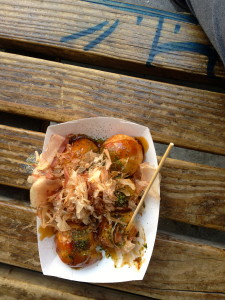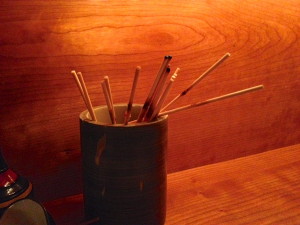I spent the weekend in New York City on book tour. On Saturday afternoon I was joined in Brooklyn by Tim Anderson, author of the hilarious memoir _[Tune In Tokyo: The Gaijin Diaries](http://www.amazon.com/gp/product/1612181317/ref=as_li_ss_tl?ie=UTF8&camp=1789&creative=390957&creativeASIN=1612181317&linkCode=as2&tag=mamstesgrubshack)_, which was an inspiration for *Pretty Good Number One.* If you enjoyed my book and haven’t read Tim’s, get on it.
Since New Yorkers love to hear about themselves, I tried to work plenty of Tokyo versus New York observations into my talk, with particular emphasis on food. Here are a couple.
* New York is a city of immigrants. Tokyo is not. The first-generation immigrant population of NYC is over 36%. In Tokyo, it’s 1%. In New York, you can find any kind of international food you want. In Tokyo, you can find any kind of Japanese food.
* New Yorkers are blunt. Tokyoites are not. When you go into a store in New York, your cashier may be chewing gum, playing with their phone, and eager to make sure you know they’re having a bad day. This will never happen in Tokyo, where such interactions are carefully scripted. On the whole, I prefer the Japanese approach, but I do like the “how you doin’?” ethic of New York. I was waiting in line for the bathroom one afternoon, and the sketchy-looking person who’d gone in before me was taking a disturbingly long time. I passed the time by sharing an enjoyable “What the fuck?” conversation with the guy behind me in line. “You want me to knock?” he offered. “Because I’ll do that.”
Here’s something that isn’t so different: New York has plenty of Japanese restaurants and shops that would be solid contenders in Tokyo.
**[Ippudo](http://www.ippudony.com/)** is a branch of a ramen chain that originated in Kyushu, Japan. Its specialty is tonkotsu ramen, thin noodles in a rich pork broth. I enjoyed the Akamaru Modern, a bowl of tonkotsu with a crimson red scoop of Ippudo’s miso blend, to be stirred into the soup before eating. A new location of Ippudo just opened in Hell’s Kitchen.
Outside Ippudo is a [Citibike](http://citibikenyc.com/) station, offering heavy-duty blue bicycles for short trips around town. All you need to get a bike is a debit or credit card, and once you’ve paid for a day ($10), week ($25), or year ($100), you can take unlimited rides of 30 minutes or less. You’re not allowed to park the bike anywhere other than a Citibike station, of which there are many in Manhattan and northern Brooklyn. A one-day pass costs as much as four subway rides, and I didn’t get my money’s worth, but I loved zipping down First Avenue to my next destination. This was my first bike ride since 1998. I have no interest in owning a bike, but if bike sharing came to Seattle, I’d use it constantly.
I rode the Citibike 2.2 miles from Ippudo to **[Ippodo](http://www.ippodo-tea.co.jp/en/shop/ny.html)**, no relation. Ippodo is a Kyoto-based tea company with shops in Japan and a brand-new New York location. Mr. Kato, from Kyoto, manned the counter, which is in the lobby of [Kajitsu](http://kajitsunyc.com/), a well-regarded vegetarian Japanese restaurant recently reviewed in the New York Times.
Kato-san and I talked about Japanese tea for a bit, and then he started brewing samples. Using a series of ceramic *tokoname* teapots, he had me try three types of *sencha* (brewed tea), one *gyokuro* (high quality shade-grown tea), and a matcha granita, churning in a slushee machine. From each pot, Kato-san poured us each a cup, took a sip of his own to ensure it had been brewed properly, and set it aside. I, meanwhile, drained each cup, and we continued to talk about tea, which more and more gesturing and broken Japanese on my part as I got fully caffeinated. My favorite was the HÅsen sencha, which has a bit of gyokuro flavor. If you like tea, think you might, or are looking for a gift for me, I can’t recommend Ippodo highly enough. The tea is reasonably priced for the quality level; the shop also sells very expensive tea ware and accessories. You can also get an inexpensive cup of tea to go.
East 9th Street, in the East Village, is like Tokyo in miniature. Beginning on Stuyvesant Street, which turns into 9th, the street features an excellent small Japanese supermarket (Sunrise Market), a bakery that also serves Japanese breakfast (Panya), a yÅshoku “Western food” restaurant (Village Yokocho), a grilled beef restaurant (Yakiniku West), a soba place (Soba-ya), a *robata* grill restaurant (Robata-ya), a teahouse (Cha-an), and the place I had lunch, **[Otafuku](http://otafukunyc.com/)**, a tiny stand-up counter serving takoyaki and okonomiyaki. Takoyaki are octopus balls—plump, gooey, spherical pancakes with a chunk of steamed octopus inside, cooked on a special griddle and served deadly hot, topped with sticky-sweet takoyaki sauce, Japanese mayo, fish flakes and seaweed. Otafuku’s are daily the best I’ve had outside Japan, although the ball was better than the perfunctory octopus bits.

Partially-eaten takoyaki at Otafuku
From Otafuku, I walked around the corner to **[Van Leeuwen](http://www.vanleeuwenicecream.com/)** artisan ice creamery for a scoop of intense black sesame.
**[Ganso](http://gansonyc.com)**, in downtown Brooklyn, answers the question, “What happens when a successful cookbook author decides to open a restaurant?” Harris Salat is the coauthor of _Japanese Hot Pots,_ _Takashi’s Noodles,_ and the forthcoming _[Japanese Soul Cooking](http://www.amazon.com/gp/product/1607743523/ref=as_li_ss_tl?ie=UTF8&camp=1789&creative=390957&creativeASIN=1607743523&linkCode=as2&tag=mamstesgrubshack)._ Ganso puts theory into practice, serving ramen (including a well-conceived spicy vegetarian ramen) and tasty small plates like broiled mackerel, gyÅza joined together with a crispy fringe, and sticky chicken wings in the style made famous at Pok Pok.
[**Eataly**](http://eatalyny.com/) is obviously not Japanese…but it sort of is. Mario Batali’s temple of all things Italian is huge and houses several restaurants, racks of pasta and olive oil and Italian beer and wine, and deli counters selling cheese, gelato, salumi, meat, and bread. Throw in some Japanese food and sink the place into the basement, and it would be a perfect recreation of a *depachika,* the lavish basement food hall found in every Japanese department store. At the bread counter I bought a square of excellent roasted red onion focaccia and had to force myself not to eat it all to save room for dinner.
[**Yakitori Totto**](http://tottonyc.com/) is simply a real Japanese yakitori experience. The cooks grill skewers of chicken, other meats, and vegetables over clean-burning charcoal. (Despite its cramped, second-floor location, Totto is oddly odorless; chalk it up to Japanese charcoal and a powerful vent fan.) If a chicken were a NYC subway map, Totto’s menu would visit every stop. Unfortunately, some of the most desirable bits (heart, cartilage, and tail) were sold out, but the *momo* (chicken thigh with onion), *tsukune* (chicken meatball with bits of soft cartilage), and shishito peppers were perfectly charred and seasoned. And Totto even has cups for discarding your empty skewers, just like in Japan.

Discarded skewers at Yakitori Totto
If I were to open a restaurant, which I definitely won’t, it would be a tempura place. You’d sit at the bar, and I would fry whatever you like to order: lotus root, onion, green beans, shrimp, fish, squash, and whatever is in season. Other than tempura, we wouldn’t serve anything other than cold drinks and maybe a plate of pickles. Every neighborhood in Tokyo has a restaurant like this, or several. I asked around, and there is no such place in NYC. Is there one anywhere in the US? Who’s going to open the first?


